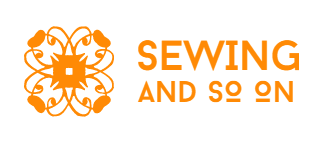Learning hand embroidery is fun, relaxing, and a great way to improve your sewing skills. Moreover, this is an easy way for you to create beautiful art with thread and fabric. Starting to learn embroidery might seem intimidating in the early stages, but most if not all patterns only need a few basic stitches with a simple stitching tutorial. Whether a newbie or an advanced beginner, these types of hand embroidery discussed in this article will help you tackle your embroidery projects easily.
30+ Hand Embroidery Techniques that Improves Your Skills Effectively
1. Open Work.
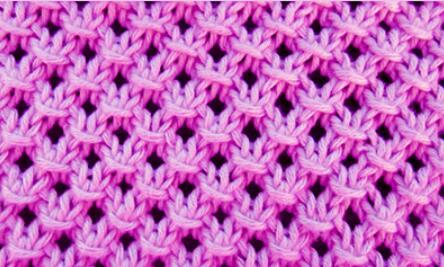
Openwork is a type of hand embroidery technique involving work in which a thread is drawn from your fabric and then, the remaining thread is tied in numerous different patterns that leave open spaces in your fabric. These open spaces create a design or pattern of their own.
Some of the different kinds of open work hand embroidery include pulled thread embroidery and the drawn thread embroidery. The drawn thread work, which is the most common under openwork, is based on removing threads from your warp of an even-weave fabric and the remaining threads bundled together to form different patterns.
Check detailed instructions on:
2. Counted thread work.
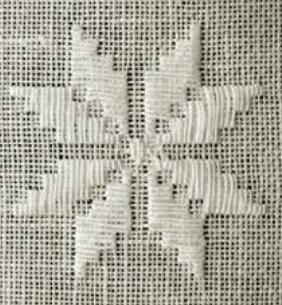
This type of hand embroidery technique requires the counting of threads in each stitch fabric so that you can form symmetrical stitches since the weft and warp thread fabrics are evenly spaced. The opposite of the counted thread work technique is. the popular, free embroidery. The cross stitch is the most common counted thread embroidery, but some sewers are also familiar with the blackwork hand-stitching technique. Other counted-thread techniques include Hardanger, needlepoint, canvas work, Florentine work, and Assisi.
Check detailed instructions on:
3. Outline Work.
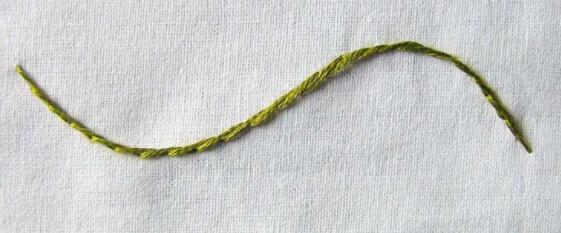
The outline work hand embroidery technique is whereby the outline of your design is worked out with stitches such as the chain stitch, stem stitch, back stitch, and outline stitch. The chain stitches hold a loop of the thread on the fabric surface. The chain stitch is popular under the outline work technique.
For a chain stitch, your needle comes up from the back of your fabric and then goes back through the same hole, pulling the thread lop almost completely via the back. Before the loop disappears completely the needle emerges again a certain distance from the initial stitch. Examples of chain stitches include detached chain, Spanish chain, and chain stitch.
Check detailed instructions on:
4. Void work.
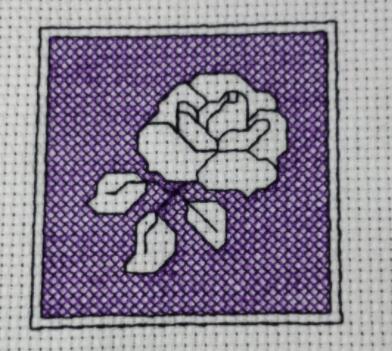
This type of hand embroidery technique fills the background of its design instead of the design itself. Together, this creates a negative design that is striking. An example of a void work technique is Assisi work. Assisi embroidery is a counted-thread embroidery that is based on traditional Italian needlework where the background is filled with the embroidery stitches, but the main motifs are not stitched.
A modern version of the Assisi technique is being practiced today. Many different colors, as well as patterns, are used for the background while the motifs remain extremely varied. However, the revived traditional technique is applicable in the town of Assisi.
Check detailed instructions on:
5. Raised work.
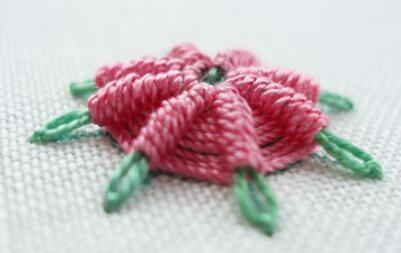
The raised work technique is also known as the stumpwork embroidery technique. It refers to a padded or raised work embroidery that is done to form a dimensional effect such as the Zardosi work and the laid work technique. In simpler terms, this style of embroidery is whereby the stitched figures are raised from your work surface to create a three-dimensional effect.
The stitches techniques can be worked around a piece or pieces of wires to form individuals such as flower petals, insect wings, or leaves. The design is then applied to the main body by piercing through background fabric and securing tightly with the wires.
Check detailed instructions on:
6. Whitework.
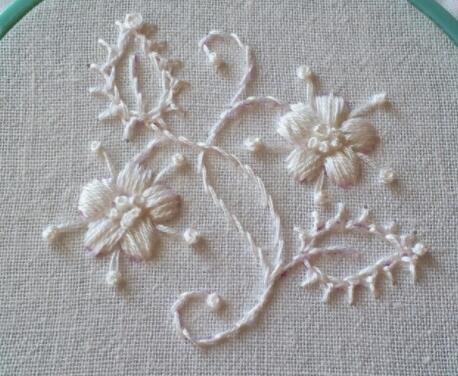
The whitework hand embroidery technique refers to any work that is done on white fabric using white embroidery floss. The hand embroidery technique is also called the French Laid Work. This technique surrounds many different types of embroidery techniques such as broderie, shadow work, and Anglaise.
The whitework technique is further divided into close and open depending on whether the fabric threads are cut. Open white work constitutes drawn thread work and any related cutwork where the threads are drawn from the background fabric to give an open lacy effect. Close embroidery produces an open effect since the threads are controlled with some being pulled apart and others grouped.
Check detailed instructions on:
7. Needle weaving.
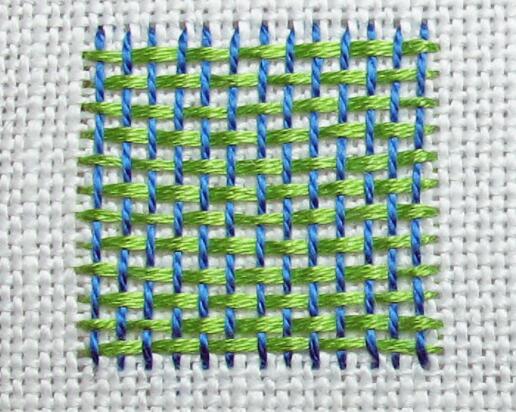
The technique is popularly known as Persian openwork. It involves drawing a thread from a fabric, either warp or weft thread. The remaining thread is then weaved using a thicker thread with re-weaving patterns or darning. The open thread is then overcast using decorative stitches. Needle weaving is one of the simplest designs to learn if you are a beginner. With this technique, you can make a wide variety of projects with different patterns.
Check detailed instructions on:
8. Candlewicking embroidery
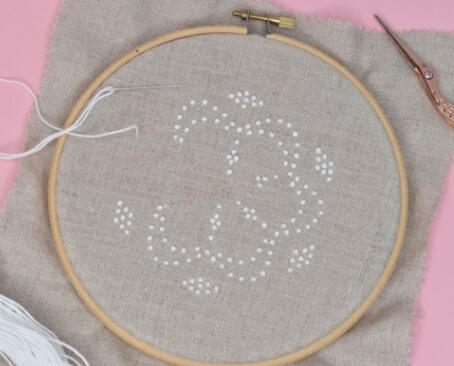
This is a type of hand embroidery that is done using a heavy thread on muslin. Typically it is a whitework hand embroidery technique that uses a white thread to embroider. A sequence of colonial knot is done on your lines of the design and is commonly done on unbleached muslin using white floss. The candlewicking embroidery obtained its name from the natural soft spun cotton thread that was braided and then utilized to create the wick for candles.
The motifs are created with a variety of ancient embroidery stitches and with tufted stitches. The parent matter is obtained from nature, that is, insects, flowers, pine trees, and more. The latest designs are colored floss embroidery with ancient white on white stitching.
Check detailed instructions on:
9. Crazy Patchwork embroidery.
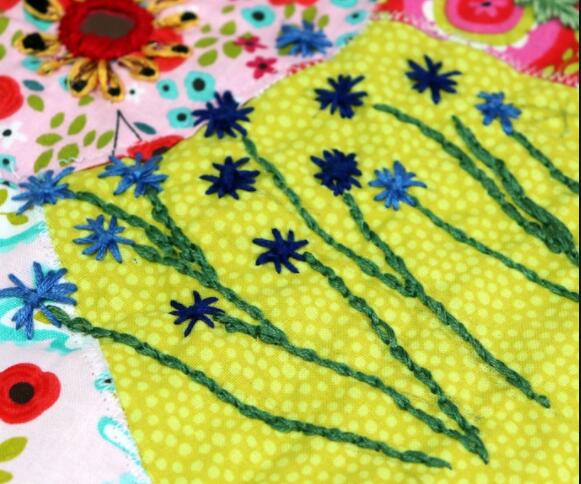
The crazy patchwork embroidery technique uses small fabric pieces that are joined on another base fabric. The fabrics are arranged according to your preferred aesthetics and thereafter, the seams are made with a decorative machine or hand stitches.
An applique technique is utilized alongside the decorative stitch for a perfect effect. The best part with the crazy patchwork embroidery technique is that you can use any stitch to embellish your design. This makes the beauty of your crazy patchwork. The technique is mostly used to embellish your quilts.
Check detailed instructions on:
10. Shadow work.
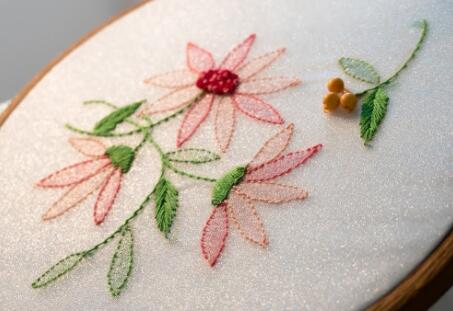
The shadow work embroidery design is mostly herringbone stitch and it is used on the back of your semi-transparent or transparent fabric so that the shadow of your work is visible on the face of your fabric in a cunning but beautiful manner.
The herringbone is the simple stitch to master, under shadow work. It is worked from left to right to make a cross-stitch on your fabric stitch and a two-row of tiny backstitch on the front for the needle to catch the fabric to create the outline of your design.
Check detailed instructions on:
11. Broderie Anglaise.
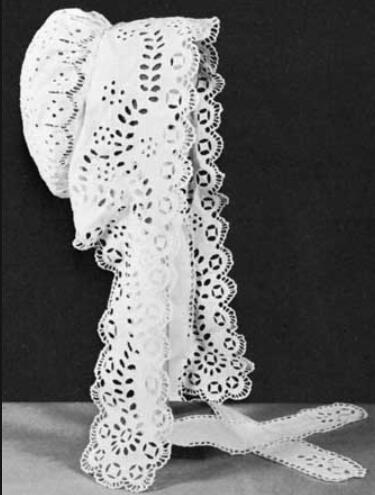
The Broderie Anglaise technique is also known as eyelet embroidery. It is a type of hand embroidery technique that is similar to cutwork, where the fabric cut stitches are made on your design lines. The cutwork and satin stitches combine to give an elegant open lace look like the design.
The Broderie Anglaise boasts patterns that resemble leaves, flowers, stems, or vines and are further described by simple embroidery stitches that are made on the surrounding fabric. In present-day western fashion, the Broderie Anglaise design has featured on different modern garments including t-shirts and shorts. It is characterized as “lace, though scaled up” making it robust and perfect for daytime wear.
Check detailed instructions on:
12. Redwork embroidery.
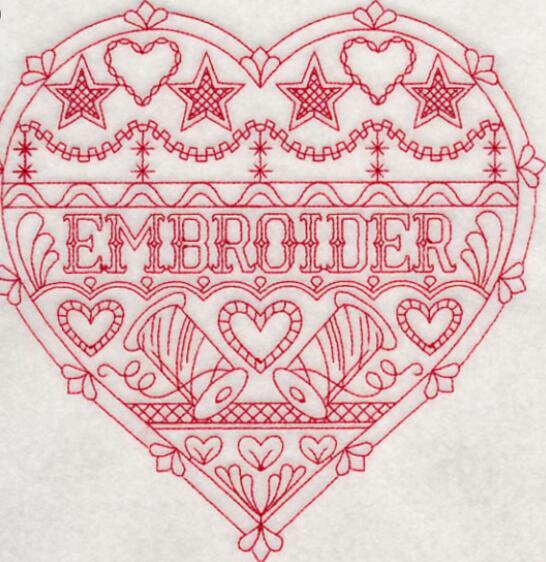
Just like the name suggests, redwork embroidery involves stitching your designs using red-colored thread embroidery against a cream or white fabric. The outlines are worked using any outline stitches such as backstitch, stem stitch, split stitch, and more.
Redwork was a popular introductory embroidery technique taught to children during the 19th and 20th centuries. The children made quilts that were decorated using redwork motifs. The motifs that were used in redwork were unique on the backsplash cloths with the words “good morning” and “good night” used on chairs, quilts, and upholstered items.
Check detailed instructions on:
13. Dotting work.
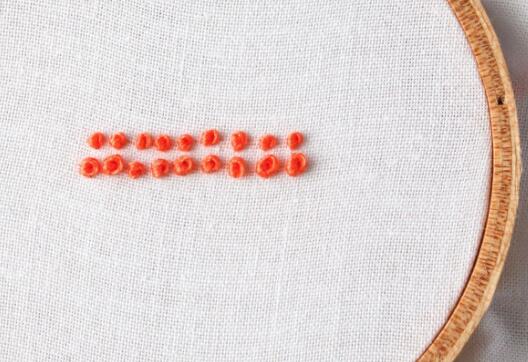
The dotting work technique involves small dots that are worked using your white thread on muslin. The most common is the French Knot, a simple embroidery stitch that forms a nubby with three-dimensions. The knot works great when strung together in lines or alone or when clustered to create a beautiful piled surface. The French are challenging to unknot and therefore, do not try it, instead of that, cut away any unwanted knots.
Check detailed instructions on:
14. Fish scale embroidery.
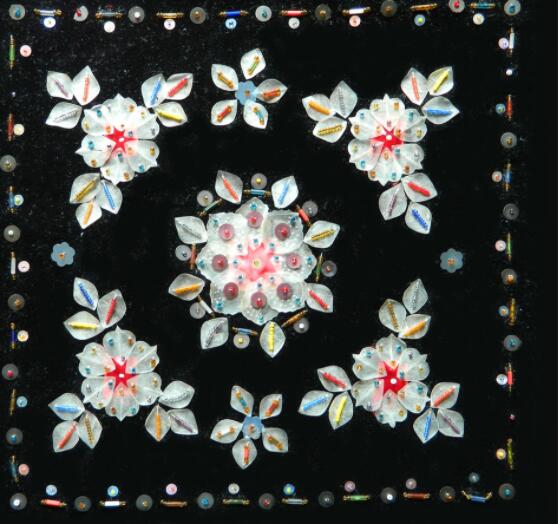
Fish scale embroidery is a type of hand embroidery technique that was very common during the 19th century in Britain. The fish scales were obtained from goldfish, carp, or perch since their scales were considered the most iridescent. The fish scales were assembled on silk, velvet, or satin ground cloth and these scales imitated bird feathers, flower petals as well as butterfly wings.
The fish scales were made by scraping them from the fish and then steeping them in water until they were pliable and soft. Two small holes were then pierced using a needle at the base of each scale. The scales were colored using a mixture of powdered color and varnish. When the scales were ready, they were arranged in an overlapping design pattern and then sewn. The center of the flowers was filled with French knots that were worked with pearls, beads, spangles, or silk.
Check detailed instructions on:
15. Pattern Darning.
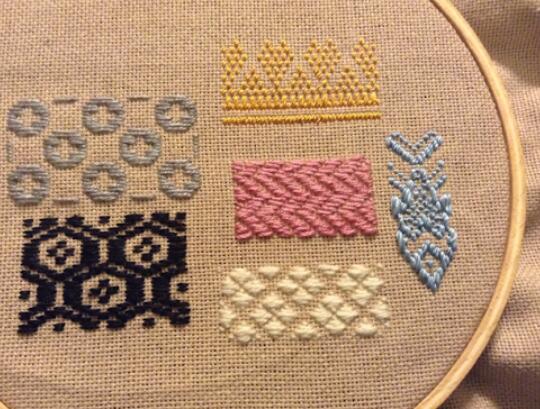
Pattern darning is a type of hand embroidery technique that uses straight stitches in parallel rows having different lengths to form a geometric design. Pattern darning has been popular since ancient times, but very common like other embroidery stitches. The possibilities of these stitch patterns are endless.
The common fabric to do pattern darning is even weaved fabric. Under pattern darning, you have to count the threads to determine the number of threads that will be filled and those that will be left alone. Moreover, you can use the embroidery floss to carry out the pattern darning. Typically this depends on the type of fabric that you are carrying out your pattern darning.
Check detailed instructions on:
16. Hardanger embroidery.
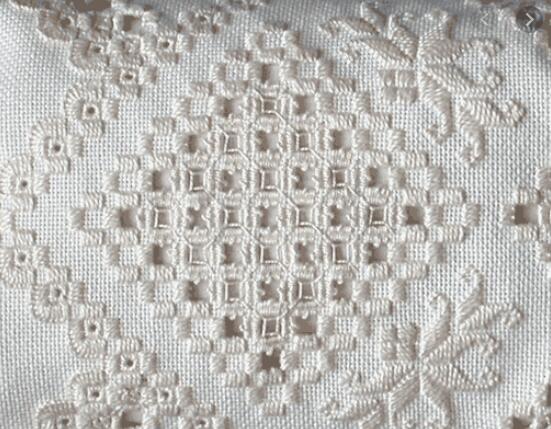
The Hardanger hand embroidery technique is a beautiful counted-technique that involves designing small cutwork between kolster blocks made of satin stitch. Moreover, one can use a pearl cotton embroidery floss for making these blocks and cut spaces using sharp scissors. The Hardanger embroidery is sometimes called the whitework embroidery since it involves working with a white thread on your even-weave cloth using drawn thread and counted thread work techniques.
The traditional Hardanger used linen even weave fabric having 36 counts or more. However, the latest Hardanger fabric is an even weave material made of cotton that is woven with thread pairs. It uses typically 22 pairs for each linen inch in both directions. It is commonly known as 22-count. The weaves outline a squared appearance to your fabric with distinct holes.
Check detailed instructions on:
17. Hedebo Embroidery.
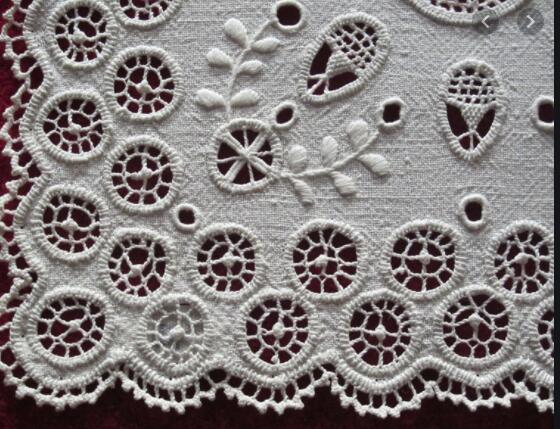
Hedebo embroidery technique covers some forms of white embroidery that originated in Hedebo, Denmark. The varied techniques improved with time until around 1820. The Hedebo embroidery technique was applied to clothing including cuffs and collars as well as decorating bed linens. The Hedebo embroidery can be classified into seven distinct styles including counted thread work, baldyring, square cutwork, drawn thread work, Hedebo needle lace, and hvidsom.
Check detailed instructions on:
18. Blackwork embroidery.
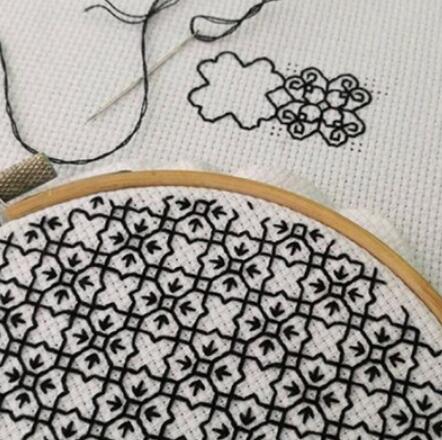
The Blackwork embroidery technique is also termed as Spanish blackwork and generally uses black thread, but other colors are still used occasionally. At times counted thread embroidery is stitched on your even-weave fabric. Ancient blackwork involved stitching in silk thread and on off-white or white or cotton fabric. Often metallic threads, as well as colored threads, are applied for accents.
The stitches applied for the counted thread are the Holbein stitch, double running backstitch, and stem stitch. The common styles of blackwork are
– Earliest blackwork. The counted stitches were worked to form a small floral or geometric pattern.
– Later blackwork. It features larger designs of fruits, flowers, and other patterns that are connected via curvilinear stems.
– Third style blackwork. The outlined patterns are shaded using random stitches known as seed stitches.
Check detailed instructions on:
19. Goldwork.
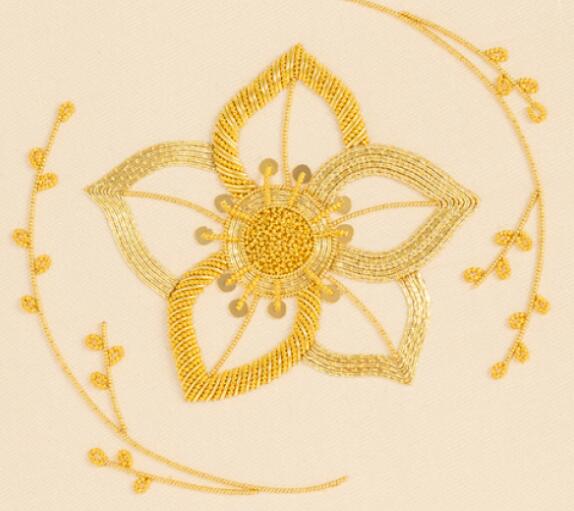
Just as the name suggests, this technique uses metal threads of different colors including gold. copper, silver for amazing effects. The gold thread is used to design an outline, raised designs, and flat. This is used alongside other stitches to make the design, but it can be used on its own. The contemporary goldwork techniques and styles have evolved due to the availability of plastic sequin waste.
Check detailed instructions on:
20. Tambour work /Aari work.
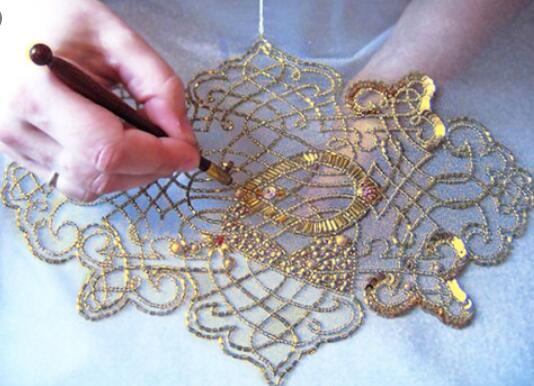
This is a type of chain stitch embroidery that uses an Ari hook for making your chain stitch. The hook makes these chain stitches by holding the thread from the back of your fabric and then creating the loop of your chain stitch. The hook results in a fast chain stitching. The hook is also called a Luneville hook.
This technique is very common in India and it is known as Zalakdozi used in making products in semiprecious stones, Kundan and crystals added to the work to give a beautiful sparkle.
Check detailed instructions on:
21. Faggoting.
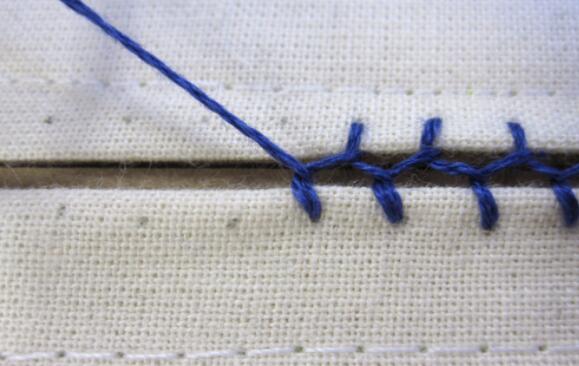
Faggoting is a hand embroidery technique of sewing two hemmed textiles together with special decorative stitching forming a zigzag pattern that leaves a narrow gap in between. Faggoting is also known as a twisted insertion stitch.
Faggoting stitch utilizes linens and soft stains with a delicate style that links two pieces of fabric at a hem level as well as creating a decorative seam. This is also a perfect way of adding some interests to your table napkins. The stitch is simple and these methods only use scrap fabric or a piece of paper and some parallel lines for evenly spaced work.
Check detailed instructions on:
22. Pulled thread work
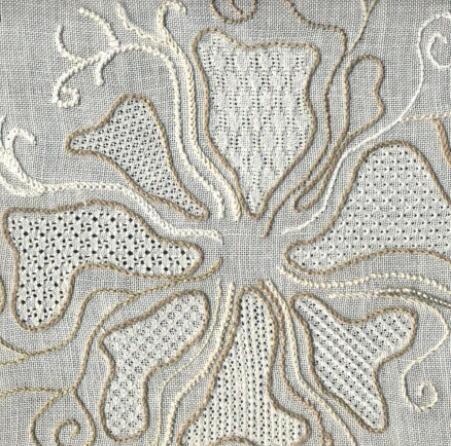
The pulled thread work technique is also known as the drawn fabric and is a kind of whitework, where the fabric threads are not cut. Instead, it is used when you are working your stitches to draw fabric thread together to give a lacy effect. The common styles used in pulled thread work include needle-weaving, basic hemstitching, cutwork, and Poltava-style drew work.
Basic hemstitching is the most basic type of drawn thread work. It is used to decorate the trimmings of your household items and your clothes The needle weaving is designed by weaving the embroidering thread into the weft or warp threads to form patterns of dark openings in the pulled thread cloth and light-colored threads.
Check detailed instructions on:
23. Cross stitch embroidery.
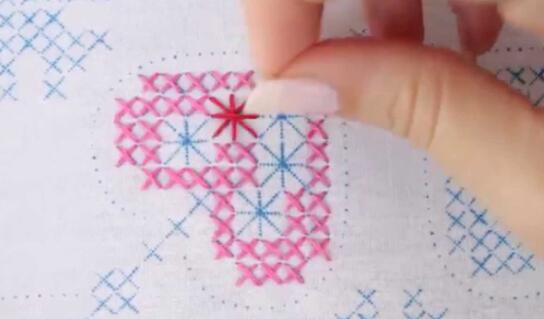
This is a well known counted thread embroidery technique where the x shaped stitches are configured to fill the design. The stitcher counts the thread on a piece of fabric such as linen in every direction so that your stitches can be of uniform appearance and size.
Sometimes the cross stitch is done on different designs that are printed on your fabric. Cross-stitch is mostly performed on easily countable fabric known as Aida cloth. It has a weave that creates visible grid squares with holes for your needle for each corner.
Check detailed instructions on:
24. Drawn thread work.
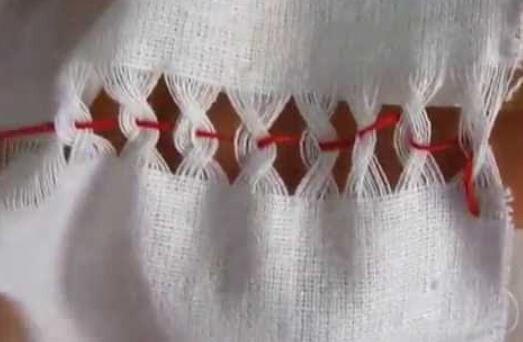
This embroidery technique uses drawing threads from a fabric and stunning decorative stitches over your remaining threads. The remaining threads are bundled or grouped into different kinds of patterns. The more detailed styles of the drawn thread work utilize a variety of other techniques and stitches, but the drawn thread sections are the most distinguishing element. This technique is also known as whitework embroidery since it was done during ancient times using a white thread on a white cloth or fabric and uses a combination of other white techniques.
Check detailed instructions on:
25. Chikankari embroidery.
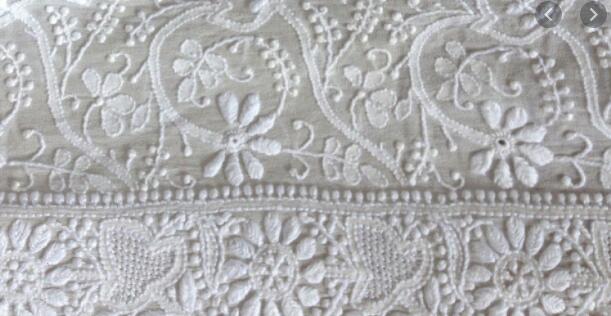
Chikankari hand embroidery technique is an Indian version of the popular shadow version. The work involves utilizing a lot of different stitches apart from the herringbone stitch including pulled thread work zigzag stitch and knot stitches.
The Chikankari embroidery work is done on a thin cotton fabric using a white embroidery thread. This is a delicate work that is done on textile fabrics such as chiffon, muslin, silk, net, organza, and more. Today, the Chikankari embroidery technique is done using silk and colored threads to meet the newest fashion trends as well as keeping Chikankari up-to-date. The Chikankari process includes the following steps: design, engraving, block-printing, embroidery, and washing and finishing.
Check detailed instructions on:
26. Sashiko embroidery.
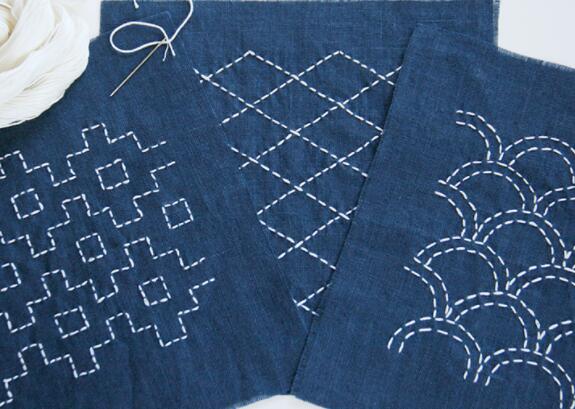
This is a Japanese embroidery technique that uses running stitches in stunning patterns. The stitches are mainly for decorative functions or reinforcement of clothing. As a result of the relatively cheap design of white cotton thread and the immense nature of the indigo-dyed cloth in Japan, the Sashiko has a unique appearance of white-on-blue, but some pieces use red thread for embroidery.
Most of the sashiko patterns were obtained from Chinese designs, but they were advanced by the native Japanese embroiders. A common style is the Kogin-Zashi that comprises diamond-shaped patterns designed in horizontal rows. This is a type of Sashiko embroidery that was developed during the Aomori prefecture.
Check detailed instructions on:
27. Chicken scratch embroidery.
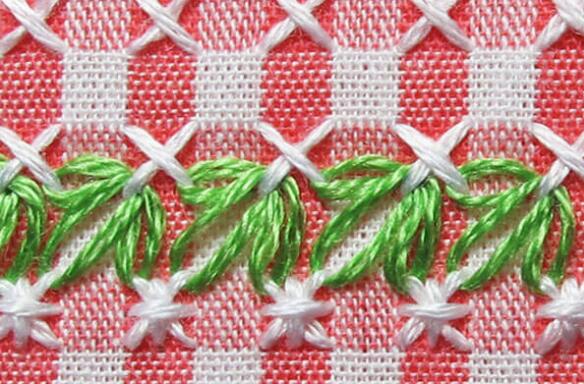
The chicken scratch embroidery involves performing cross stitches on your gingham cloth or rather checked fabric. Chicken scratch embroidery is also called Amish embroidery, snowflake embroidery, or depression lace embroidery. The names are after the designs that the chicken scratch makes, which look like snowflakes or lace along with your gingham fabric.
This type of hand embroidery technique is a cheap version of designing a lace look for less and is common on the edging of your materials. The main reason why chicken is preferred on your gingham is that during the depression, this material was a cheap fabric. Moreover, it is easy to follow it as a guide for cross stitches. You can use any color or size of gingham.
Check detailed instructions on:
28. Canvas work/needlePoint.
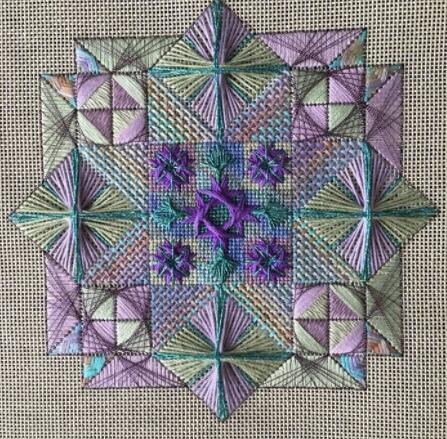
The canvas work is a type of hand embroidery technique that is done on your cloth or canvas with stitches that fill the design. The Persian wool is the most used to perform the stitches. It is often worked on with your open weave canvas fabric and the colors are matched in this embroidery to create a reasonable effect. The Gross point hand embroidery is a type of canvas that is done using large needlepoint stitches.
Check detailed instructions on:
29. Laid work embroidery.
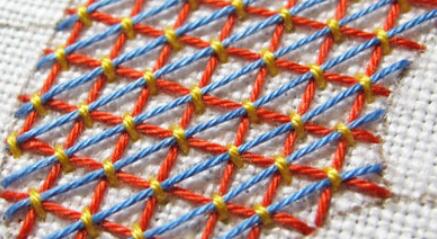
Laid work embroidery is a type of hand embroidery technique that is similar to couching. Laid work typically has three and above layers of thread, but couching has two layers of thread. The first layer of Laid work embroidery consists of a sequence of stitches that are placed side-by-side to fill the needed shape.
The next layer of thread, cross stitches or crossing threads, are designed at right angles to your laid threads. Both layers are held in place on your ground material using small stitches described as tying down stitches or couching stitches.
Check detailed instructions on:
30. Silk ribbon embroidery.
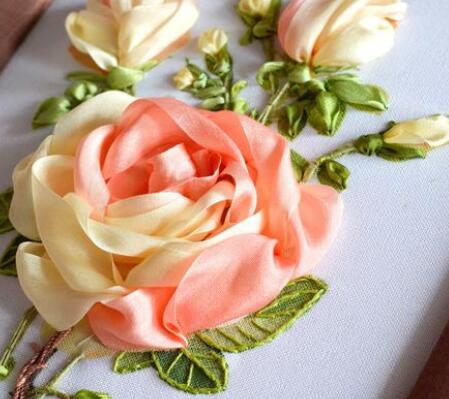
This type of hand embroidery technique is usually done using a synthetic or silk ribbon that is threaded on your needle instead of embroidery floss. Most of the kits meant for silk ribbon embroidery come with designs printed on the cloth or fabric, then you carry out the ribbon work. It has a three-dimensional effect that is very phenomenal. You can enhance your embroidery work using beads and embroidery stitches.
Check detailed instructions on:
31. Crewel embroidery
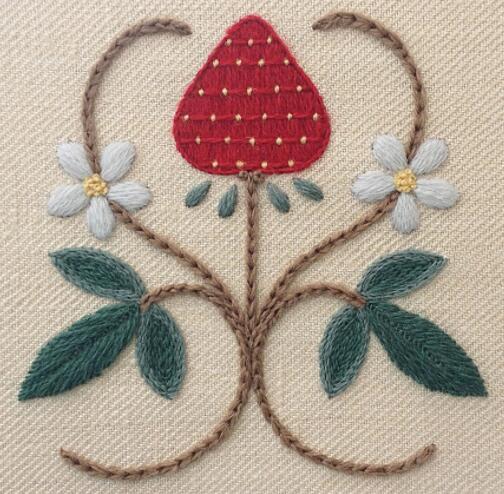
This is a type of embroidery that uses crewel wool to make the designs on your linen. Crewel embroidery is also known as Jacobean embroidery. Many varieties of embroidery stitches are used to make the design outline used on the fabric.
The modern crewel wool is one-ply yarn, but two-ply is also available and in different colors. The outlines of the design are screen printed onto your fabric or transferred using the latest transfer pens that contain water-soluble ink.
In conclusion, this article has given you 30 plus different types of hand embroidery techniques, leaving you in a better position to advance your sewing skills either as a newbie or an advanced beginner.
Check detailed instructions on:
